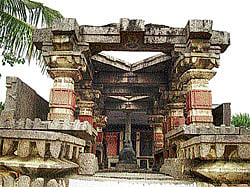
Centuries ago, sculptors used their ingenuity and skill to build marvellous structures
Unknown temple sculptors of the eleventh century during the Kakatiya dynasty in the present day Telangana region and the Maharanas of Orissa during 7th century AD in Srikakulam of coastal Andhra built two temples that have a similar and unique character.
The ''viswakarmas'', as they were called, summoned the sun god to visit the sanctum sanctorum of the temples by directing the bright rays to fall on the feet of the lord.
In the Trikutaalaya of Kalpagur village of Medak district , 61 km from Hyderabad, everyday the rays of the sun pass through the Nandeeswara, Ranga and Artha mantapas to land at the feet of Anantapadmanabha Swami, one of the three main deities at the Trikutaalaya.
The rays illuminate the sanctum sanctorum that house the Kasi Visweswara, Venugopala and the Anantapadmanabha Swami in bright colours.
Legend has it that in the 11th century the temple was built by the Kakatiya kings and Vontimitta Obulayya, a sculptor with only one hand, carved the stones.
The mantapas are reminiscent of the thousand-pillar temple in Warangal and also the Ramappa temple, which were built much later than the Kalpagur temple.
According to the Madapathi family, the hereditary priests of the temple, people in this region believe that this temple is one among the half crore lingas that Lord Rama established during his exile. Records show that Kalpagur had been the capital of the founder of the Reddy dynasty, Raminedu.
The temple itself was built on a pedestal shaped as a star. The huge blocks of stone were arranged without any plaster or adhesive joining them.
Now the pedestal is mostly covered with elevated path built recently by the temple management.
Interior of the temple is built with black basalt rock. But, years of neglect has damaged the three distinctive sikharas of the temple. The villagers used mortar to repair them, which gave the 11th century temple a modern look.
The temple is run only with the help of donors and volunteers in the village. The best time to visit this temple is Sivaratri, Vysakha Shuddha Padyami, Vidiya and Akshaya Tritiya.
Arasavilli
Unlike Trikutaalaya, sun rays enter and fall on the deity only twice a year at Arasavilli tempe. The temple is believed to have been built in the 7th century AD by the Kalinga rulers Devendra Varma of Orissa. Arasavilli is located at Srikakulam town near Visakhapatnam in Andhra Pradesh.
Legend has it that Indra, the king of gods, attempted to force his entry into the temple of Koteeshwara and was thrown away by gatekeeper Nandi. Repentful of his arrogance in attempting to force his entry, Indra enshrined Surya, the sun god, in a temple and performed worship services, at Artisanal.
A black granite image of Surya (Padma Pani), about 5 feet in height bearing lotus buds, flanked by his consorts Padma, Ushas and Chicana, on a seven-horse driven chariot is main deity here. At the base of the image are the gate keepers Pinnula and Dania and the saints Sankara and Santana. Sutra charioteer Aryan is also depicted in the image.
The temple is a edifice with Adyta in the centre, with Ganesha, Shiva, Parvati and Vishnu in four corners of the quadrangle. An image of Indra, the builder
of the temple, is also enshrined in this temple. Ratha Saptami is the most
important festival which is celebrated in this temple.
This temple is a testimony to the architectural skills of vishwakarmas. It is believed that the vishwakarma Brahmin sculptors, also called as Maharanas in Orissa, had planned the architecture and sculpted this engineering master piece. The temple is built in such a way that the sun rays fall on the feet of the idol twice a year in the months of February and June during the early hours of the day. The phenomenon lasts a few minutes .
Hundreds of devotees throng the Suryanarayana Swamy temple at Arasavilli, on Rathasaptami day. “The rays that fall on the feet, naval and head of the statue look beautiful at that time,” the temple authorities said.
The devotees believe that people who worship Sun god get health, wealth and happiness. That is why the village is also called “Harshavalli” (happy village).